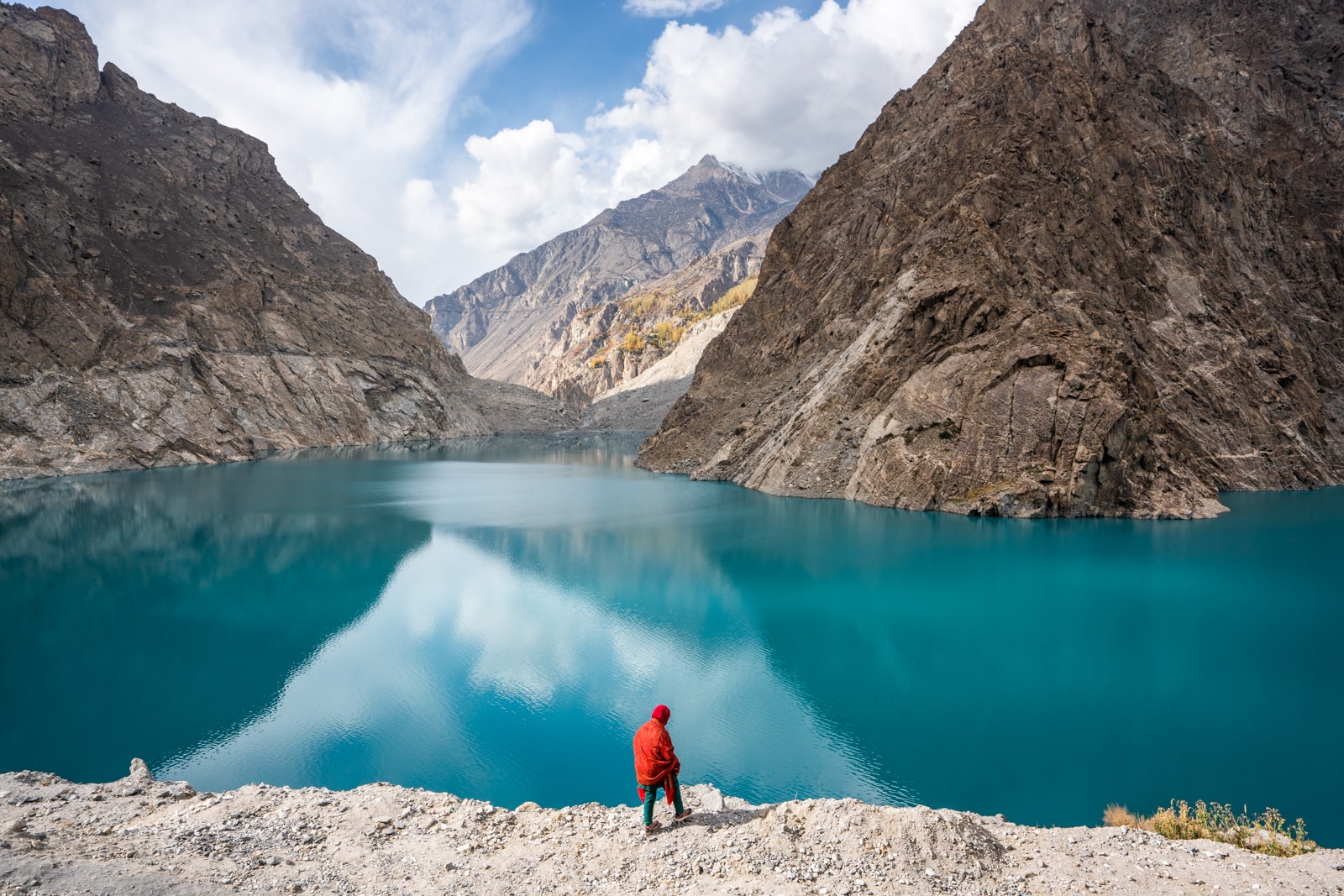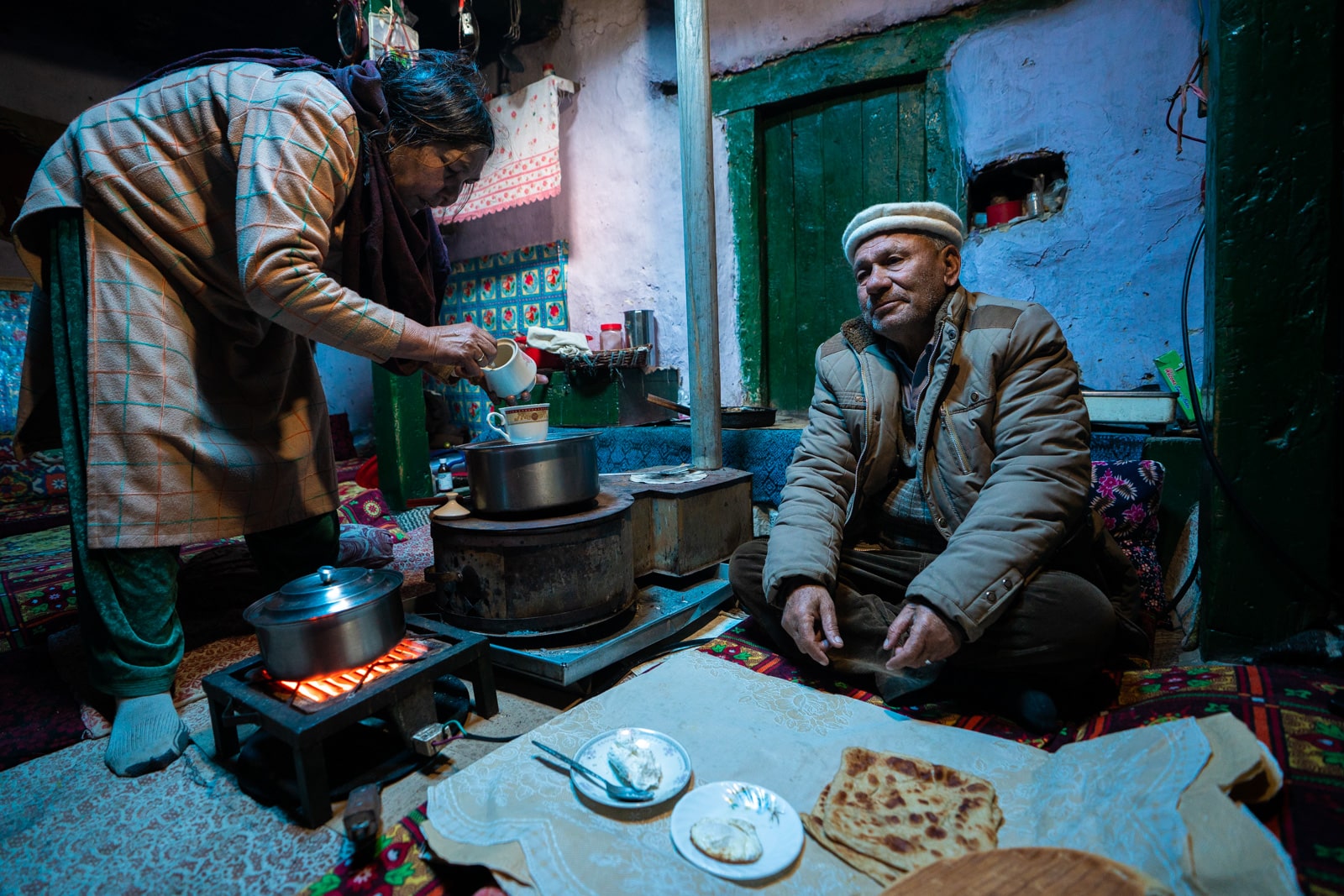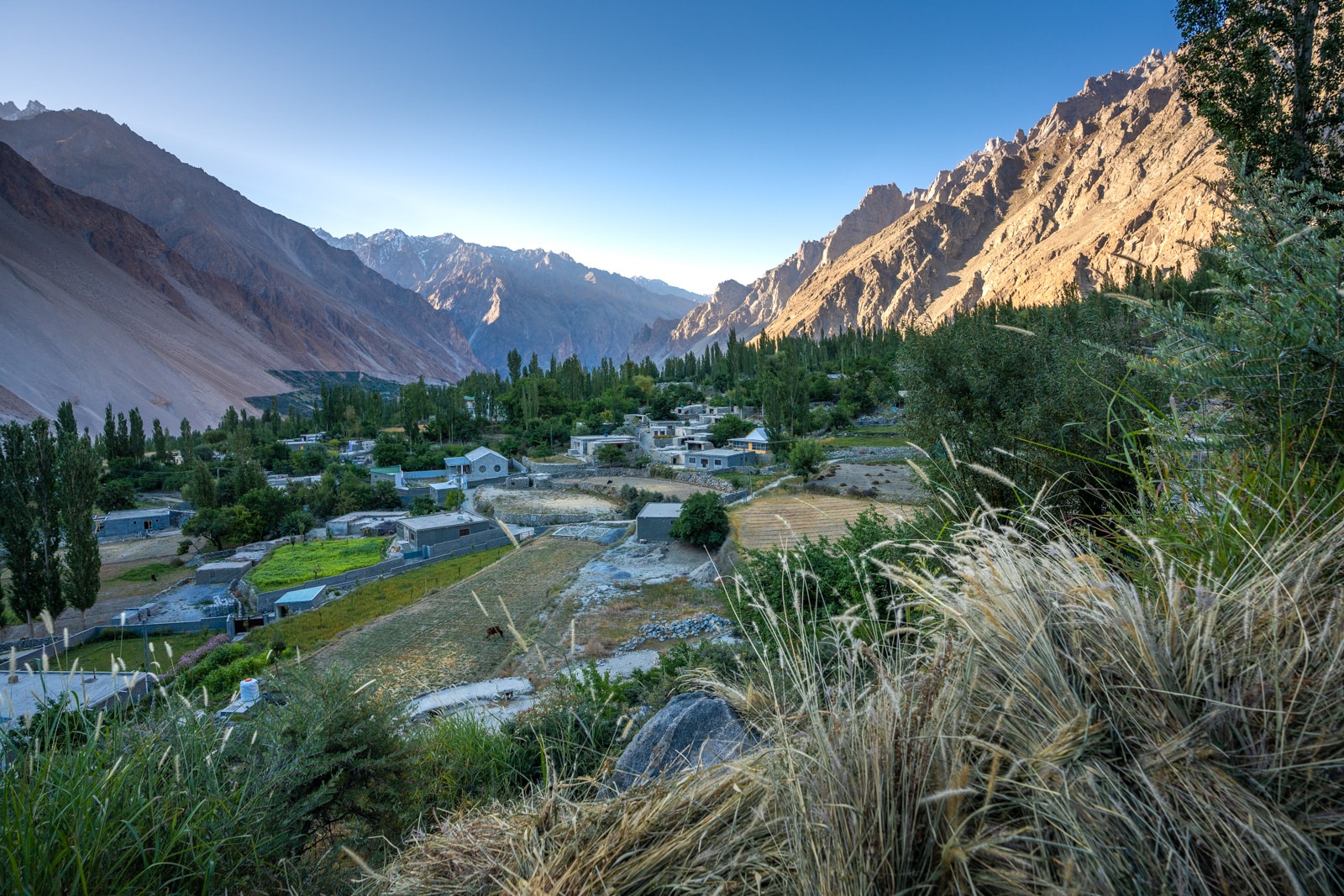Hidden Hunza summer tour itinerary
Considering joining our Hidden Hunza Pakistan tour this summer? Here’s our full summer tour itinerary to help you decide. Spoiler alert: it’ll be wild.
Anything is possible in Pakistan. This is our planned itinerary… but things don’t always go according to plan! From chai invites to landslides, delays can happen anywhere and everywhere. Flexibility is important.
Think of this itinerary as more of a guideline than an exact schedule. We might make changes on the fly, but we’ll still do our best to cover everything mentioned.
Day 1: Islamabad

Faisal Mosque, Islamabad
- We all meet in the real world!
- Shah Allah Ditta caves
- Golra Railway Station
- Faisal Mosque
- Sleeping: Islamabad hotel
- Signal: Wifi, 4G
Our tour begins in Pakistan’s calm capital. Straight roads, less traffic, and leafy greenery make our first day a gentle one. It’ll be too hot, you’ll be jet lagged, and the next day of driving will be long, so we’ll take it easy.
Note: It’s useful to arrive in Islamabad a day or two before the tour starts to give yourself time to get acclimated before we drive off to the mountains.
Day 2: Drive to Chilas (long driving day)

Lulusar Lake
- Driving time: 12 – 15 hours
- Picnic lunch
- Photo stop at Lulusar Lake
- Photo stop at Babusar Pass (4,173 m/13,691 ft)
- Sleeping: Chilas hotel
- Signal: Spotty 3G/4G in towns
Alas, it’s a long drive north… but it’ll be worth it, we swear! The drive is broken up into two days for your comfort and safety. Driving late at night is risky due to poor roads, and our driver needs to sleep! Trust us: you don’t want to drive with someone who’s been awake for 20 hours.
Driving time depends on how often we stop, weather and road conditions, etc. The road is very bumpy and winding at times. If you have back problems, get motion sickness, or have other transportation-related issues, keep this in mind.
We’ve tried to time this tour to avoid monsoon rains and landslides (the biggest causes of delays), but you never know in the mountains, especially given our current climate crisis.
On the bright side: mountain scenery will entertain you on the way, and we’ll stop for a scenic picnic lunch and chai whenever cravings strike.
Day 3: Drive Chilas to Gulmit (long driving day)

Attabad Lake
- Driving time: 5 – 7 hours
- Photo stop at junction point of Karakoram, Hindu Kush, Himalaya mountain ranges
- Lunch and photo stop at Rakaposhi viewpoint
- Boating on Attabad Lake, time permitting
- Sleeping: Gulmit traditional homestay
- Signal: Bad wifi in Gulmit, bad 2G mobile signal
Now we’re talking mountains! It’s another long day of driving—though less than the previous day—but we’ll be treated to such fantastic views by the end that your butt won’t notice. Almost.
We’ll break up the drive with photo stops at mountain viewpoints, and lunch roadside shacks with the prettiest backgrounds you’ve ever seen. Oh, and boat across Attabad, one of the bluest lakes in Pakistan… if we don’t get too distracted by everything else.
After the long and arduous drive, we’ll finally reach the first place we can call “home” on this trip: a traditional Hunzai home in the village of Gulmit in upper Hunza Valley.
Day 4: Gulmit (2,465 m/8,087 ft)

Ondra Fort, Gulmit
- Village walk
- Women’s carpet center
- Old House
- Trek to Ondra Fort (3km/1.8mi, 1 to 2 hours)
- Sleeping: Gulmit traditional homestay
- Signal: Bad wifi in Gulmit, bad 2G mobile signal
Our first day in Gulmit is all about wandering around and getting your first feel of Hunza. Old stone and mud houses, winding dirt paths lined with trees, and both men and women out on the streets always ready with a smile and greeting—what better introduction to Pakistan’s north could you ask for?
The day will be distinctly female in flavor, with visits to both a women-run carpet center—a great place for authentic souvenir shopping that directly supports local women—and a women-run cafe serving up all kinds of local Hunzai food.

After that, it’s time to burn off some calories (necessary, at this point) by trekking up a dirt road to the mysterious ruins of Ondra Fort. Even locals don’t know exactly how old it is, but the views from the top are spectacular—you can see Gulmit, Attabad Lake, and the Passu Cones from the top—and it’s not every day you can have an entire ancient fortress to yourself!
Day 5: Passu and the suspension bridge trek

Passu suspension bridge
- Village walk in Passu
- Hussaini Bridge to Passu Bridge trek (8km/5mi, 3-5 hours)
- Sleeping: Gulmit traditional homestay
- Signal: Bad wifi in Gulmit, 4G in Passu
Time to venture to one of the oldest and most picturesque villages in Hunza: Passu. Situated riverside near the feet of the famous Passu Cones, the village is a collection of cute stone houses, farm fields, and fruit trees.
After a little village wander, we’ll head out for a trek between two suspension bridges: the Passu and Hussaini bridges. Perilous and nerve wracking even for the most confident adventurers, the bridges are a sight… and make for excellent bragging and/or Indiana Jones references for friends and family at home.
The trek between the two bridges isn’t too steep nor difficult by local standards, but it does include a long, gradual uphill.
Day 6: Shimshal Valley (3,100 m/10,700 ft)

Shimshal village
- Driving time: 4 hours
- Sleeping: Shimshal traditional homestay
- Signal: Bad 2G
Onwards to our first of several Hunzai side valleys: Shimshal, home to some of the highest villages in Pakistan!
Getting there will be a quest. We’ll pack into jeeps and drive along one of Pakistan’s most terrifying dirt roads to reach the remote valley. Regardless of whether or not you want to look out the window, Shimshal’s green fields and friendly folks are sure to be worth the sweat and nerves you’ll have along the way.
Day 7: Shimshal

Shimshal
- Village walk
- Sleeping: Shimshal traditional homestay
- Signal: Bad 2G
Time to slip into a village pace of life! Today is for wandering around the village and getting to enjoy the scenery and meet some of the friendly locals that make Shimshal what it is.
We’ll drink too much chai and eat local with people in their homes in between wandering the village ways. You can wander around with the group or on your own—Shimshal is very safe, and we’re here to help connect you with good experiences, not be your babysitters!
Day 8: Shimshal trek

Yazghil glacier, Shimshal
- Trekking to shepherds’ huts (5-7 hours)
- Sleeping: Tents
- Signal: None
Shimshal is heaven for trekkers, and though we’re not undertaking any massive expeditions, we have to do at least one overnight trek to enjoy the surroundings!
We’ll be trekking to some local shepherds’ huts in the pastures. In summers, shepherds bring up flocks of goats, sheeps, and yaks to graze in the grassy high alpine pastures above the valley.
The trek won’t be too strenuous, but it will take several hours. Know that trekking trails are often loose or uneven in Pakistan; these aren’t the manicured hiking trails you might be used to in other countries. Your biggest challenge is altitude—we’ll be at around 3,500 meters (11,500 ft) and you might feel short of breath on the uphills. Don’t worry, we’ll make sure we have enough time for everyone to go at their own pace and take plenty of breaks if necessary.
Once there, we’ll set up camp and chill for the night before trekking back to the village. No need to worry about bringing camping gear—unless you really prefer using your own tent and sleeping bag—we’ll provide everything, and we’ll pay local porters to carry all of our supplies to camp.
Day 9: Shimshal

Shimshal village
- Trekking back to Shimshal
- Sleeping: Shimshal traditional home
- Signal: Bad 2G
Time to head back to Shimshal! We’ll head back the way we came. Once back in the village, everyone can rest, relax, and take (bucket) showers if you’re in need of a scrub.
Day 10: Misgar (3000 m/9,850 ft)

Misgar Valley
- Driving time: 4-5 hours
- Sleeping: Misgar homestay
- Signal: None
Little Misgar is the least touristed of all the Hunza side valleys. Only a stone’s throw from the Karakoram Highway, this is the last valley before the Pakistan-China border, and was used as a border outpost during the British colonial era.
We’ll be back in jeeps to drive from Shimshal to the Karakoram Highway (bumpy), then up the KKH for a time before turning off to Misgar (less bumpy). You can finally relax and give your bum a break once we reach Misgar village surrounded by green fields and old houses.
Day 11: Misgar

Local home in Misgar
- Village walks
- Sleeping: Misgar homestay
- Signal: None
Village life moves at a slow pace, and this is your chance to do so, too. We’ll go for strolls around the village, head up the mountainside for some too-gorgeous views over the village, spot some little British leftovers, eat all kinds of local food, and generally relax and enjoy the peace of Misgar.
Day 12: Chapursan Valley (3,500 m/11,500 ft)

Chapursan Valley
- Driving time: 4 hours
- Village walk
- Sleeping: Zudkhun homestay/guesthouse
- Signal: Occasional signal for calls and texts
Our final valley destination is Chapursan, Pakistan’s gateway to Afghanistan’s Wakhan Corridor and Tajikistan’s Pamir region.
Chapursan is otherworldly. One of the most remote valleys in Pakistan, most of its people are ethnically Tajik. Few trees are found in its barren landscapes, but you’ll find a plethora of goats, sheep, and yaks if you head high enough.
The first day in Chapursan is simply for getting in along the winding dirt road that leads from the Karakoram Highway through the valley. Our jeeps will take us past several villages before stopping at the last village in the valley: Zudkhun.
Day 13: Chapursan

Chapursan
- Baba Ghundi shrine
- Lakeside picnic
- Sleeping: Zudkhun homestay/guesthouse
- Signal: Occasional signal for calls and texts
A shrine to a Sufi saint, Baba Ghundi, lies at the end of Chapursan Valley. Green pastures filled with grazing animals surround the Baba Ghundi area, and if we’re lucky, we might encounter some Kyrgyz nomads! During summers, they cross from the Wakhan Corridor into Chapursan with yaks and livestock to trade with locals.
We’ll take jeeps to Baba Ghundi, then on the way back—weather permitting—we’ll wander through some surreal rocky landscapes bordered by a glacial river and a small lake. Perfect picnic spot, amirite? If it’s sunny/warm enough, you can even swim in the little lake.
The spot is about an hour’s walk from Zudkhun, so those who want to can return to the village on foot.
Day 14: Passu (2,485 m/8,150 ft)

Passu village
- Driving time: 4 hours
- Village walk
- Sleeping: Passu guesthouse
- Signal: 4G
Remember Passu? That crazy scenic village at the foot of the Passu cones we stopped in before? Yep, we’re heading back there for a couple of days.
After a few bumpy hours on the Chapursan dirt track, we’ll rejoin the (blissfully smooth) Karakoram Highway. You’re finally free from jolting jeep rides!
You can use this afternoon to explore a bit more of peaceful Passu, chat a bit with the friendly villagers, and generally relax after days of rough travel.
Day 15: Passu & Khunjerab Pass (4,733 m/15,528 ft)

Khunjerab Pass
- Driving time: 6 hours
- Visit highest paved international border crossing in the world
- Sleeping: Passu guesthouse
- Signal: 4G
As far as border crossings go, it doesn’t get much cooler than Khunjerab. Literally and figuratively.
The Khunjerab Pass between Pakistan and China is the highest paved border crossing in the world. It’s so high, there are oxygen machines in the border waiting area!
Obviously we won’t be able to cross the border—unless you have a Chinese visa and want to run away from us—but we can drive through Khunjerab National Park to the border gate with China. It’s a long drive, but the road is good and the views, epic. We’ll head back to Passu after visiting the border.
Alternatively, if you don’t feel like sitting in the car all day, you can stay behind to continue roaming around Passu or trek to the nearby Passu Glacier.
Note: If you want to cross into China after visiting Pakistan, it’s possible to do so on this day. We know some of you have some crazy travel plans in mind! We can help you arrange transportation into China if so desired.
Day 16: Karimabad & Altit (2,500 m/8,200 ft)

Baltit Fort, Karimabad
- Driving time: 1.5 hours to Karimabad, 2 hours to Danyor
- Baltit Fort
- Lunch at a women-run cafe
- Altit Fort
- Sunset at Eagle’s Nest
- Sleeping: Danyor homestay
- Signal: 4G
When Pakistanis tell you “You must visit Hunza!!!”, Karimabad is what they’re talking about. By far the most popular place in Hunza (which actually stretches all the way to Khunjerab, but not many people realize that), Karimabad and Altit are as close to touristy as it gets in Gilgit Baltistan. They get quite busy in summer, so be prepared.
We’ll divide our time between Karimabad, home to Baltit Fort, and Altit, where a fort of the same name is located. Beautifully restored by the Aga Khan Foundation, the forts are some of the best-maintained historical sites in Pakistan. Between fort visits we’ll hit the town for local food and souvenir shopping, if desired.
To finish the day off right, we’ll watch sunset at a famous viewpoint named Duikar, Eagle’s Nest, then drive down south to a town called Danyor to rest our weary heads at a local home.
Day 17: Drive to Naran (long driving day)

Naran-Babusar road
- Driving time: 8 hours
- Picnic lunch
- Cross Babusar Pass (4,173 m/13,691 ft)
- Sleeping: Naran hotel
- Signal: 4G, Wifi
All good things must come to an end… including our time in the mountains! Sigh.
It’s time to begin our journey down south. Much like the drive up north, this day will be long. Prepare your podcasts and ready your snacks, we’ve got a drive ahead of us.
We’ll stop for the night in Naran, one of THE tourist destinations for locals in Pakistan. It’ll be a big shift after our time in the mountains, but it’s an interesting opportunity to see what full-on domestic tourism looks like in the country.
Day 18: Drive to Islamabad (long driving day)

Food stop in Qalandarabad
- Driving time: 8 hours
- Sleeping: Islamabad hotel
- Signal: 4G, Wifi
And so, after a long drive, we find ourselves back where we began: the capital.
We’ll have our final family dinner together (sob) and then tuck in for a much deserved (and probably much needed) sleep after a long few days of travel.
Day 19: Head home 🙁
If you’re flying from Islamabad we’ll provide you with an airport transfer.
If staying longer, traveling to other parts of Pakistan, or thinking of crossing the border into India (beware, it’ll be hot), we can help you arrange further accommodation and transportation.

